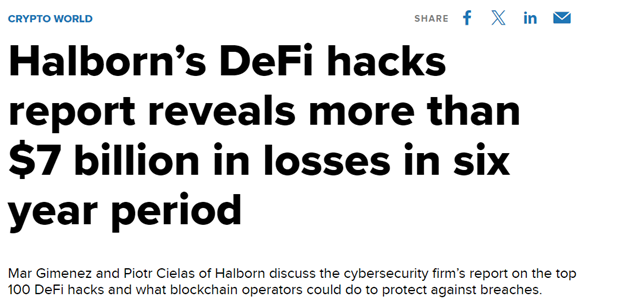5 Opportunities & 5 Challenges for Crypto in 2025
 |
| By Jurica Dujmovic |
In all my years dealing with crypto, I've witnessed countless cycles of innovation, setbacks and breakthroughs.
Now, as we approach 2025, I see our community facing perhaps its most critical juncture yet.
One that will determine whether crypto fulfills its original promise of financial freedom … or becomes co-opted by the very institutions it was meant to circumvent.
To that end, I see five storm clouds gathering on the horizon that could hinder crypto progress. I also see five silver linings that keep me optimistic about our future.
Let’s start with the former …
The Gathering Storm
The first headwind I foresee is the shifting regulatory landscape.
Heading into 2025, this will be more complex than ever, around the world. While the EU pushes ahead with their MiCA framework — which seeks to institute uniform EU market rules for crypto — the U.S. presents a fascinating dichotomy.
I’ve observed President-Elect Donald Trump's evolution from crypto skeptic to advocate. And I'm intrigued by his proposals for a national Bitcoin (BTC, “A”) reserve and emboldened by his stance against current SEC Chair Gary Gensler's aggressive regulatory approach.
The potential shift of oversight from the SEC to the CFTC could be a game-changer for innovation in our space.
But let's not kid ourselves: A more crypto-friendly administration doesn't mean complete freedom from oversight. Nor should we expect change to come overnight.
The challenge will be finding the sweet spot between necessary consumer protections and maintaining the innovative spirit that made cryptocurrency revolutionary in the first place. And finding that balance will likely take trial, error and time.
From my perspective, we need just enough regulation to keep out the bad actors without strangling the very innovation that makes crypto worthwhile.
My second concern is the rise of Central Bank Digital Currencies, or CBDCs.
I've warned about this before. And now, I’ve watched China's digital yuan rollout with growing unease. Especially since the ECB's digital euro is following suit.
Let's call these what they really are: tools of financial surveillance and control, masked as innovation.
CBDCs may dress up as cryptocurrencies. But they are neither trustless nor decentralized. They are, in truth, the antithesis of what Satoshi envisioned — a way for central banks to tighten their grip on financial freedom rather than loosen it.
And the push to roll out more is a red flag in my book.
Similar reasons have put the influx of institutional money as third on my list of crypto challenges for the coming year.
While I remember celebrating when the first major investment firms started taking Bitcoin seriously, I now see a different kind of threat. These institutions aren't just buying crypto; they're reshaping it in their image.
And no wonder! Bank of America says a total of $38 billion poured into the various spot Bitcoin and Ethereum (ETH, “A-”) ETFs so far this year!

The decentralized, peer-to-peer network we built is becoming just another Wall Street playground.
If we’re not careful, we could blindly allow our crypto space to become more centralized and correlated to the TradFi market.
The fourth challenge I foresee is the security of our networks.
There has been a recent string of DeFi hacks. And it reminds me of the early Mt. Gox days.
If you’re newer to the crypto space, Mt. Gox was a Bitcoin exchange based in Japan. By early 2014, it was handling over 70% of all BTC transactions worldwide. Then, it abruptly ceased operations amid revelations of its involvement in the loss/theft of hundreds of thousands of BTC, then worth hundreds of millions in USD.
The only difference is that now, the stakes are much higher.

Crypto infrastructure needs to mature rapidly to handle the increasing sophistication of attacks.
The final storm cloud on the horizon is the persistent scalability concerns that plague most networks.
Solutions like Layer-2 protocols and Ethereum's transition toward sharding have made significant strides. However, their full adoption and integration across the ecosystem are still ongoing. More concerningly, the fundamental challenge of scaling without compromising decentralization remains unsolved.
Reasons for Hope
The concerns I listed are serious. But things aren’t all doom and gloom!
In fact, I'm incredibly excited about several developments that could help cryptocurrency return to its roots while expanding its potential.
Starting with the fact that DeFi is finally able to deliver on its promise of financial inclusion.
The decentralized finance sector isn’t just creating new financial products. It is revolutionizing access to credit for people who've been ignored by traditional banks.
I've watched with amazement as farmers in Southeast Asia and small business owners in Africa have gained access to capital through these platforms, often for the first time in their lives.
This is bigger than just making loans available. With the start of the new year around the corner, DeFi is finally poised to fundamentally change who gets to participate in the global economy.
When I first got into crypto, I heard talk about banking the unbanked. Now? I can watch it happen in real time.
These peer-to-peer lending protocols have stripped away the gatekeepers and their arbitrary requirements. No more need for pristine credit scores or banking relationships that span generations.
Instead, we're seeing community-based lending that works for everyone, not just the privileged few.
The second silver lining is that privacy technology will likely continue to make remarkable strides.
Zero-knowledge proofs — once a theoretical curiosity — are becoming practical solutions for maintaining transaction privacy while satisfying regulatory requirements. This could be our path to preserving financial privacy in an increasingly surveilled world.
Third on my optimistic outlook is the increasingly robust developer ecosystem we can expect.
Looking at where we stand in crypto today reminds me of the early internet boom. The tools being built, the grants being distributed and the rapid innovation in the crypto space are creating a foundation for a truly decentralized future.
Every week brings new breakthroughs in smart contract capabilities and blockchain efficiency.
The fourth reason for optimism is that interoperability protocols are finally delivering on their promise.
I’ve touched on the importance of interoperability before. In the earlier days of crypto, it was impossible to send assets to non-native networks. Then, it was possible … but inconvenient and expensive.
The ability to seamlessly move assets and information between different blockchains efficiently and inexpensively isn't just convenient — it's revolutionary. It means we can have specialized chains for different purposes while maintaining a unified ecosystem.
In short, it greatly expands what the average person can do with their crypto … without needing to be an expert.
And the fifth, and perhaps most exciting optimistic outlook, is the growth of decentralized storage and computing platforms.
This infrastructure layer, often overlooked in crypto discussions, is crucial for breaking free from big tech's stranglehold on the internet. Projects like Filecoin and Arweave are more than just storage solutions. They're the backbone of a new, decentralized internet.
So, there you have it. But since this is the season for giving, I’ll give you one more vital reason to get excited for the future of crypto.
It’s the most significant shift of all. And one that will echo well beyond 2025.
Right now, we have an entire generation that will grow up with fundamentally different assumptions about how money should work.
Look, it’s been over a decade since Bitcoin came on the scene. Where you and I grew up in a world where money was physical, and financial tools were gatekept, kids today have been brought up with the world at their fingertips, thanks to their keyboards.
This new audience isn't adopting crypto. They're living in a world where digital money is the default starting point.
I suspect this shift will define the years to come more than any technical breakthrough or regulatory framework.
For this next generation, the distinction between different forms of digital money — be it crypto or CBDCs — isn't ideological, it's practical. They'll choose whatever works best in the moment, whatever lets them move value most efficiently, whatever their friends are using.
This is where our real work begins. Our challenge isn't to convince this new generation that crypto is better. Our goal is to build crypto infrastructure that is so intuitive, so efficient and so empowering that it is by far and away the better option for financial freedom.
If we can make …
- Our decentralized lending platforms more accessible than traditional banks
- Our privacy tools more user-friendly than government-based alternatives
- Our networks faster and cheaper than centralized solutions
Then we won't need to convince anyone of anything. New users will choose crypto because it simply works better.
Looking back at my decade in crypto, I've learned that true adoption never comes from preaching. It comes from building solutions that make people's lives better.
As we move through 2025, I believe the crypto market will finally be positioned to do exactly that.
So, be sure to stick with us. Not just through this current rally, but into 2025 as well. Because there will be plenty of choppy waters to navigate as crypto continues to establish itself as a viable alternate financial system.
And plenty of opportunity for investors along the way.
Best,
Jurica Dujmovic

